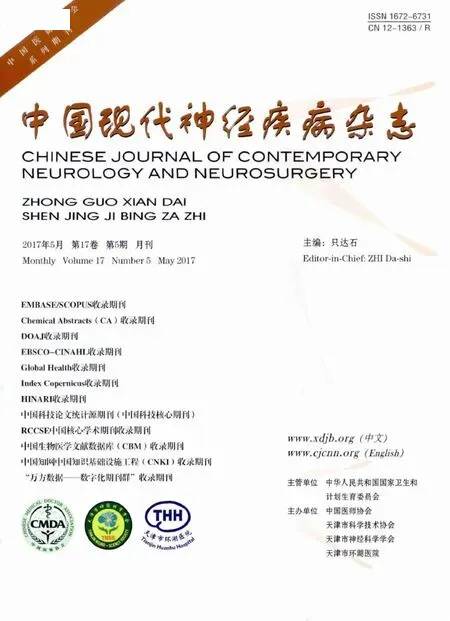光学相干断层扫描术在中枢神经系统疾病中的应用
敖然 于生元
光学相干断层扫描术在中枢神经系统疾病中的应用
敖然 于生元
中枢神经系统疾病较为复杂,常规检查方法易受患者主观因素的影响而缺乏准确性,通过光学相干断层扫描术(OCT)可以客观检测眼球后结构改变,进而反映神经元变性情况。本文旨在探讨OCT技术在中枢神经系统疾病中的应用,并寻找新型生物学标志物。
体层摄影术,光学相干; 中枢神经系统疾病; 综述?
视神经在胚胎发育过程中起源于外胚层,属于中枢神经的一部分[1]。视神经和眼底结构可以在一定程度上反映中枢神经系统疾病。中枢或周围神经系统病理性损害可以导致神经元变性[2],神经元变性可发生于视觉通路[3]。视觉通路由三级神经元组成,一级神经元为视网膜双极细胞,其周围支与视觉感受器视锥细胞和视杆细胞形成突触,其中枢支与二级神经元节细胞形成突触,节细胞轴突形成视神经,向后延伸形成视束,止于外侧膝状体三级神经元,其轴突形成视辐射,止于枕叶皮质[4]。顺行神经元变性自视网膜至视辐射或视皮质,逆行神经元变性则自视皮质或视辐射至视网膜[5]。上述病理改变在疾病初期通常呈亚临床变化,常规检测难以发现,光学相干断层扫描术(OCT)可以早期发现组织结构改变,为及时治疗提供时机。
OCT技术是一种非侵袭性、可重复性、无创性眼科检查方法,其技术原理与超声类似,根据眼部各组织结构不同折光率获得眼底结构的横断面成像,从而检测视网膜、脉络膜等结构,分辨率达5~10 μm,接近病理结构水平[6]。OCT 技术还可以检测视乳头旁和黄斑区视网膜神经纤维层(RNFL)厚度。光学相干断层扫描增强深部成像(EDI⁃OCT)是新型OCT技术,与传统OCT技术相比,具有较高的信噪比(SNR),分辨率高达2 μm,同时增加视觉追踪系统,可于数微秒内捕捉到眼球后结构变化,呈现视网膜各层结构和脉络膜结构,并形成三维图像,从而更直观地观察中枢神经系统疾病[7⁃8]。脉络膜是血供最丰富的结构,为视网膜外层和部分视神经供血,其结构改变可以在一定程度上反映血供异常[9]。既往主要采用超声或荧光素眼底血管造影(FFA)对脉络膜进行检测,不能直观反应脉络膜结构,EDI⁃OCT技术由于更靠近眼球,可以清晰获得脉络膜图像,实现快捷、无创性检测脉络膜。
一、中枢神经系统脱髓鞘疾病
多发性硬化(MS)、视神经脊髓炎谱系疾病(NMOSD)是中枢神经系统脱髓鞘疾病,病变常累及视神经,导致视神经炎。视神经炎包括炎症反应、脱髓鞘改变、轴索损伤等,这一过程可能导致视网膜节细胞死亡、黄斑体积缩小、视觉功能障碍或永久性失明[10]。疾病早期影像学检查可能无异常,眼科检查仅发现亚临床改变,如果能够获得早期诊断和及时治疗,患者预后良好。
1.多发性硬化 有25%~50%以急性视神经炎首发的患者最终证实为多发性硬化[11]。尸检显示,49例多发性硬化患者中35例发生视网膜神经纤维层萎缩[12]。1999 年,Parisi等[13]首次将 OCT 技术用于多发性硬化,他们对有视神经炎表现且视力恢复较好的患者进行OCT检测,发现仍有6/14例患侧视网膜神经纤维层和4/14例健侧视网膜神经纤维层较正常对照者变薄。视神经炎致视网膜神经纤维层厚度改变与视觉诱发电位(VEP)P100波幅降低相一致,提示轴索变性[14]。视神经损害早期视网膜节细胞内丛状层即变薄,故可准确筛查出早期视神经损害[15]。
2.视神经脊髓炎谱系疾病 研究显示,视神经脊髓炎谱系疾病患者视乳头周围各象限视网膜神经纤维层均变薄,特别是上象限和下象限,提示轴索直径较薄的区域不易受累。与多发性硬化患者相比,视神经脊髓炎谱系疾病患者黄斑区视网膜神经纤维层显著变薄[16],提示后者的视神经炎较前者更易导致视网膜神经纤维层变薄,且出现时间更早,这可能是由于抗水通道蛋白4(AQP4)抗体聚集使血⁃脑屏障(BBB)通透性增加[17]。
二、神经变性病
1.帕金森病 帕金森病(PD)是临床常见的神经变性病,其病理改变是黑质多巴胺能神经元变性缺失和路易小体(LB)形成,临床以运动症状为主,表现为运动迟缓、静止性震颤、肌张力增高、姿势平衡障碍[18]。视觉障碍在帕金森病患者中较为常见,主要表现为视物模糊、视物成双、幻视等[19]。视觉相关检查常受帕金森病患者认知功能障碍的影响而缺乏准确性,影像学检查可以较客观地反映眼部各组织结构异常。有学者提出,多巴胺在视网膜视觉成像过程中发挥一定作用[20],而帕金森病患者视网膜多巴胺水平减少可能导致视觉障碍,补充左旋多巴制剂可以改善症状[21]。OCT技术是客观检测视网膜形态学的方法,可以反映出神经元功能和突触传递。Bodis⁃Wollner等[22]对 24 例帕金森病患者和17例性别、年龄相匹配的正常对照者进行OCT检查,结果显示,帕金森病患者视网膜、视网膜神经纤维层内上和内下象限均较正常对照者变薄。Jiménez等[23]认为,帕金森病严重程度与视乳头旁视网膜神经纤维层厚度有关,帕金森病患者视乳头旁各象限视网膜神经纤维层均较正常对照者变薄。Garcia⁃Martin等[24]探讨帕金森病患者生活质量与中央凹视网膜神经纤维层厚度的相关性,发现中央凹视网膜神经纤维层厚度减少与帕金森病严重程度相关。α⁃突触核蛋白(α⁃Syn)在帕金森病的发生与发展中发挥重要作用,其聚集与路易小体(LB)形成和多巴胺能神经元变性缺失密切相关。α⁃Syn参与脂质连接、线粒体功能和突触传递[25]。有研究显示,α⁃突触核蛋白基因(SNCA)表达于脊椎动物视网膜外丛状层[26]。病理学研究显示,视网膜内层细胞间质α⁃Syn 表达上调[19]。Satue等[27]采用 OCT 技术检测帕金森病患者视网膜神经纤维层厚度,发现视网膜外丛状层视网膜神经纤维层较正常对照者变薄;亦有研究显示,视网膜其他层视网膜神经纤维层也变薄[28⁃29]。因此,α⁃Syn 对视网膜结构的影响尚待进一步验证。
2.阿尔茨海默病 近年关于阿尔茨海默病(AD)患者视觉障碍的研究逐渐增多,眼部症状常出现在痴呆前[30]。OCT技术可以在阿尔茨海默病早期即发现亚临床证据,从而早期诊断阿尔茨海默病。研究显示,随着阿尔茨海默病的进展,视网膜神经纤维层逐渐变薄,黄斑体积与简易智能状态检查量表(MMSE)评分显著相关[31]。因此,OCT 技术是评价阿尔茨海默病严重程度的便捷方法。
三、原发性头痛
1.偏头痛 偏头痛是发作性神经系统疾病,我国患病率约为9%[32]。皮质扩散性抑制(CSD)是公认的有先兆偏头痛的病理生理学机制[33],是神经元去极化后出现的兴奋性抑制,通过释放大量炎性因子和神经递质以激活三叉神经血管系统,最终导致偏头痛[34]。三叉神经血管系统包括三叉神经、颅内外脑膜血管,以及脑干、颅外软组织、眼部等[35]。亦有学者开始关注偏头痛患者眼球后结构变化。研究显示,偏头痛发作期脉络膜厚度显著增加[36],偏头痛非发作期脉络膜厚度较正常对照者减少,可能是由于偏头痛反复发作致脑血流量减少,使脉络膜变薄;其中,有先兆偏头痛组脉络膜厚度减少得更明显[37],此与有先兆偏头痛易引起颅内血管事件相一致[38]。Martinez等[39]发现,偏头痛组患者视网膜神经纤维层厚度较对照组减少,视网膜神经纤维层厚度与偏头痛残疾程度评价问卷(MIDAS)、偏头痛发作频率和病程相关。视网膜神经纤维层变薄可能是逆行性神经元变性所致,皮质扩散性抑制源于枕叶皮质,视觉先兆发生时枕叶血流量减少[40],偏头痛反复发作可以引起视觉皮质神经元逆行性变性,从而导致视网膜神经纤维层变薄。
2.丛集性头痛 丛集性头痛是临床最为常见的三叉神经自主神经性头痛,表现为偏侧头痛、程度剧烈,严重影响生活质量[41]。多项研究显示,丛集性头痛发作时眼部血管发生血流动力学改变,从而导 致 视 觉 障 碍[42]。Ewering 等[43]采 用 OCT 技 术 对107例丛集性头痛患者视网膜神经纤维层厚度进行检测,发现双眼颞侧象限视网膜神经纤维层厚度均较正常对照者减少,其中,慢性丛集性头痛患者黄斑区视网膜神经纤维层厚度较偶有头痛发作者和正常对照者均减少,提示视网膜神经纤维层厚度改变可能是长期血供异常所致。
综上所述,OCT技术是非侵袭性、可重复性、无创性检测方法,不受患者主观影响,可以客观、精确地捕捉眼球后结构变化,广泛应用于中枢神经系统疾病的早期诊断,尤其对存在眼部症状的中枢神经系统疾病、神经变性病和发作性疾病具有重要临床意义。视网膜神经纤维层厚度有望成为新型生物学标志物,可以早期发现亚临床改变,为疾病早期诊断提供依据。
[1]Wilson SW,Houart C.Early steps in the development of the forebrain.Dev Cell,2004,6:167⁃181.
[2]Wang JT,Medress ZA,Barres BA.Axon degeneration:molecular mechanisms of a self⁃destruction pathway.J Cell Biol,2012,196:7⁃18.
[3]Kelle J,Sánchez⁃Dalmau BF,Villoslada P.Lesions in the posterior visual pathway promote trans⁃synaptic degeneration of retinal ganglion cells.PLoS One,2014,9:E97444.
[4]Jia JP,Chen SD.Neurology.7th ed.Beijing:People's Medical Publishing House,2013:5⁃6[.贾建平,陈生弟.神经病学.7版.北京:人民卫生出版社,2013:5⁃6.]
[5]Graham SL,Klistorner AI,Grigg JR,Billson FA.Objective VEP perimetry in glaucoma:asymmetry analysis to identify early deficits.J Glaucoma,2000,9:10⁃19.
[6]Podoleanu AG.Optical coherence tomography.Br J Radiol,2005,78:976⁃988.
[7]Nakano T,Hayashi T,Nakagawa T,Honda T,Owada S,Endo H,Tatemichi M.Applicability of automatic spectral domain optical coherence tomography forglaucomamassscreening.Clin Ophthalmol,2016,11:97⁃103.
[8]Bock M,Brandt AU,Dörr J,Pfueller CF,Ohlraun S,Zipp F,Paul F.Time domain and spectral domain optical coherence tomography in multiple sclerosis:a comparative cross⁃sectional study.Mult Scler,2010,16:893⁃896.
[9]Spaide RF,Koizumi H,Pozonni MC.Enhanced depth imaging spectral⁃domain optical coherence tomography. Am J Ophthalmol,2008,146:496⁃500.
[10]Frohman EM,Frohman TC,Zee DS,McColl R,Galetta S.The neuroophthalmology of multiple sclerosis.Lancet Neurol,2005,4:111⁃121.
[11]Kale N.Management of optic neuritis as a clinically first event of multiple sclerosis.Curr Opin Ophthalmol,2012,23:472⁃476.
[12]Serbecic N,Beutelspacher SC,Kircher K,Reitner A,Schmidt⁃Erfurth U.Interpretation of RNFLT values in multiple sclerosis⁃associated acute optic neuritis using high⁃resolution SD⁃OCT device.Acta Ophthalmol,2012,90:540⁃545.
[13]Parisi V,Manni G,SpadaroM,Colacino G,Restuccia R,Marchi S, Bucci MG, Pierelli F. Correlation between morphological and functional retinal impairment in multiple sclerosis patients.Invest Ophthalmol Vis Sci,1999,40:2520⁃2527.
[14]Trip SA,Schlottmann PG,Jones SJ,Altmann DR,Garway⁃Heath DF,Thompson AJ,Plant GT,Miller DH.Retinal nerve fiber layer axonal loss and visual dysfunction in optic neuritis.Ann Neurol,2005,58:383⁃391.
[15]Al⁃Louzi OA,Bhargava P,Newsome SD,Balcer LJ,Frohman EM,Crainiceanu C,Calabresi PA,Saidha S.Outer retinal changes following acute optic neuritis.Mult Scler,2016,22:362⁃372.
[16]Bennett JL,de Seze J,Lana⁃Peixoto M,Palace J,Waldman A,Schippling S,Tenembaum S,Banwell B,Greenberg B,Levy M,Fujihara K,Chan KH,Kim HJ,Asgari N,Sato DK,Saiz A,Wuerfel J,Zimmermann H,Green A,Villoslada P,Paul F;GJCF⁃ICC&BR.Neuromyelitis optica and multiple sclerosis:seeing differences through optical coherence tomography.Mult Scler,2015,21:678⁃688.
[17]Hofman P,Hoyng P,vanderWerf F,Vrensen GF,Schlingemann RO.Lack of blood⁃brain barrier properties in microvessels of the prelaminar optic nerve head.Invest Ophthalmol Vis Sci,2001,42:895⁃901.
[18]Armstrong RA. Visual symptoms in Parkinson's disease.Parkinsons Dis,2011:ID908306.
[19]Schulz⁃Schaeffer WJ.The synaptic pathology of alpha⁃synuclein aggregation in dementia with Lewy bodies,Parkinson's disease and Parkinson's disease dementia.Acta Neuropathol,2010,120:131⁃143.
[20]Rodnitzky R.Visual dysfunction in Parkinson's disease.Clin Neurosci,1998,5:102⁃106.
[21]Rohani M,Langroodi AS,Ghourchian S,Falavarjani KG,Soudi R,Shahidi G.Retinal nerve changes in patients with tremor dominant and akinetic rigid Parkinson's disease.Neurol Sci,2013,34:689⁃693.
[22]Bodis⁃Wollner I,Kozlowski P,Glazman S,Miri S. α⁃Synuclein in the inner retina in Parkinson disease.Ann Neurol,2014,75:964⁃966.
[23]Jiménez B,Ascaso FJ,CristóbalJA,López delValJ.Developmentofa prediction formula ofParkinson disease severity by optical coherence tomography.Mov Disord,2014,29:68⁃74.
[24]Garcia⁃Martin E,Rodriguez⁃Mena D,Satue M,Almarcegui C,Dolz I,Alarcia R,Seral M,Polo V,Larrosa JM,Pablo LE.Electrophysiology and optical coherence tomography to evaluate Parkinson disease severity.Invest Opthalmol Vis Sci,2014,55:696⁃705.
[25]Uversky VN.Alpha⁃synuclein misfolding and neurodegenerative diseases.Curr Protein Pept Sci,2008,9:507⁃540.
[26]Martinez⁃Navarrete G,Martin⁃Nieto J,Esteve⁃Rudd J,Angulo A,Cuenca N.Alpha synuclein gene expression profile in the retina of vertebrates.Mol Vis,2007,18:949⁃961.
[27]Satue M,Garcia⁃Martin E,Fuertes I,Otin S,Alarcia R,Herrero R,Bambo MP,Pablo LE,Fernandez FJ.Use of fourier domain OCT to detectretinalnerve fiber layer degeneration in Parkinson's disease patients.Eye,2013,27:507⁃514.
[28]Albrecht P,Müller AK,Südmeyer M,Ferrea S,Ringelstein M,Cohn E,Aktas O,Dietlein T,Lappas A,Foerster A,Hartung HP,Schnitzler A,Methner A.Optical coherence tomography in parkinsonian syndromes.PLoS One,2012,7:E34891.
[29]Garcia⁃Martin E,Larrosa JM,Polo V,Satue M,Marques ML,Alarcia R,Seral M,Fuertes I,Otin S,Pablo LE.Distribution of retinal layer atrophy in patients with Parkinson disease and association with disease severity and duration. Am J Ophthalmol,2014,157:470⁃478.
[30]Kesler A,Vakhapova V,Korczyn AD,Naftaliev E,Neudorfer M.Retinal thickness in patients with mild cognitive impairment and Alzheimer's disease.Clin Neurol Neurosurg,2011,113:523⁃526.
[31]Cheung CY,Ong YT,Hilal S,Ikram MK,Low S,Ong YL,Venketasubramanian N,Yap P,Seow D,Chen CL,Wong TY.Retinal ganglion cell analysis using high⁃definition optical coherence tomography in patients with mild cognitive impairment and Alzheimer's disease.J Alzheimers Dis,2015,45:45⁃56.
[32]Yu S,Liu R,Zhao G,Yang X,Qiao X,Feng J,Fang Y,Cao X,He M,SteinerT.The prevalence and burden ofprimary headaches in China:a population⁃based door⁃to⁃door survey.Headache,2012,52:582⁃591.
[33]Woods RP,Iacoboni M,Mazziotta JC.Brief report:bilateral spreading cerebral hypoperfusion during spontaneous migraine headache.N Engl J Med,1994,331:1689⁃1692.
[34]Moskowitz MA,Nozaki K,Kraig RP.Neocortical spreading depression provokesthe expression ofc⁃fosprotein⁃like immunoreactivity within trigeminal nucleus caudalis via trigeminovascular mechanisms.J Neurosci,1993,13:1167⁃1177.
[35]Abdul⁃Rahman AM,Gilhotra J,Selva D.Dynamic focal retinal arteriolar vasospasm in migraine.Indian J Ophthalmol,2011,59:51⁃53.
[36]Dadaci Z,Doganay F,Oncel Acir N,Aydin HD,Borazan M.Enhanced depth imaging optical coherence tomography of the choroid in migraine patients:implications for the association of migraine and glaucoma.Br J Ophthalmol,2014,98:972⁃975.
[37]Gipponi S,Scaroni N,Venturelli E,Forbice E,Rao R,Liberini P,Padovani A,Semeraro F.Reduction in retinal nerve fiber layer thickness in migraine patients.Neurol Sci,2013,34:841⁃845.
[38]Murinova N, Krashin DL, Lucas S. Vascular risk in migraineurs:interaction of endothelial and cortical excitability factors.Headache,2014,54:583⁃590.
[39]Martinez A,Proupim N,Sanchez M.Retinal nerve fiber layer thickness measurements using optical coherence tomography in migraine patients.Br J Ophthalmol,2008,92:1069⁃1075.
[40]Tedeschi G,Russo A,Conte F,Corbo D,Caiazzo G,Giordano A,Conforti R,Esposito F,Tessitore A.Increased interictal visual network connectivity in patients with migraine with aura.Cephalalgia,2016,36:139⁃147.
[41]May A. Cluster headache: pathogenesis, diagnosis, and management.Lancet,2005,366:843⁃855.
[42]Buture A, Gooriah R, Nimeri R, Ahmed F. Current understanding on pain mechanism in migraineand cluster headache.Anesth Pain Med,2016,6:E35190.
[43]Ewering C,HaşalN,Alten F,Clemens CR,Eter N,Oberwahrenbrock T,Kadas EM,Zimmermann H,Brandt AU,Osada N,Paul F,Marziniak M.Temporal retinal nerve fibre layer thinning in cluster headache patients detected by optical coherence tomography.Cephalalgia,2015,35:946⁃958.
The application of optical coherence tomography in central nervous system diseases
AO Ran,YU Sheng⁃yuan
Department of Neurology,Chinese PLA General Hospital,Beijing 100853,China
YU Sheng⁃yuan(Email:yusy1963@126.com)
Central nervous system diseases are complicated,and general examinations are lack of accuracy because they are easily influenced by subjective factors of patients.Objective results from optical coherence tomography(OCT)can detect the changes of ocular posterior structures,and then further reflect the neuronal degeneration.The aim of this review is to discuss the application of OCT in central nervous system diseases and look for new biomarkers.
Tomography,optical coherence; Central nervous system diseases; Review
This study was supported by the National Natural Science Foundation of China(No.81471147).
10.3969/j.issn.1672⁃6731.2017.05.013
国家自然科学基金资助项目(项目编号:81471147)
100853 北京,解放军总医院神经内科
于生元(Email:yusy1963@126.com)
2017⁃04⁃06)

